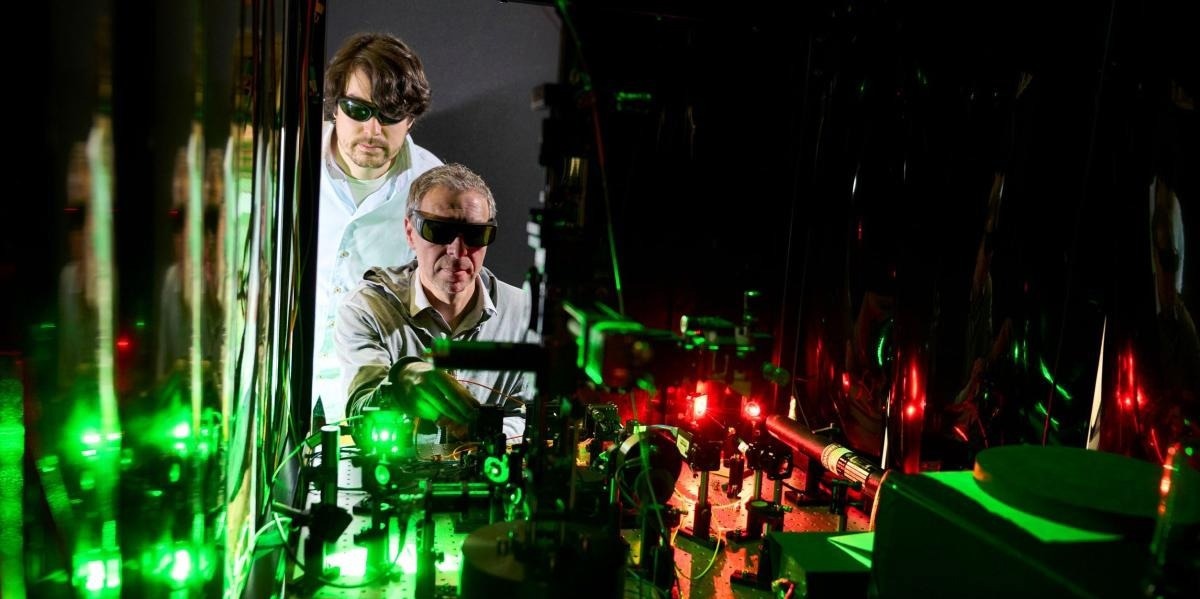Innovative, ultra-thin nanomaterials display extraordinary qualities. Fascinating physical events can happen, for instance, when individual crystal layers that are atomically thin are stacked vertically. Superconductivity, for instance, could be present in bilayers of the wonder material graphene that have been twisted by the magic angle of 1.1°.

Physicists Anvar Baimuratov (left) and Alexander Högele in their laboratory at LMU. Image Credit: Jan Greune / LMU
Additionally, bilayer semiconducting heterostructures, which are held together by weak van der Waals forces and made of so-called transition metal dichalcogenides, are a focus of investigation.
Such unique heterostructures, which are not present in nature, are studied by the research team led by Alexander Högele.
The combination of materials, the number of layers, and their relative orientation give rise to a wide variety of novel phenomena. In the lab, we can tailor physical phenomena for various applications in electronics, photonics, or quantum technology with properties that are unknown in naturally occurring crystals.
Alexander Högele, Physicist, Ludwig Maximilian University of Munich
But as a recent study published in the journal Nature Nanotechnology shows, it is not always simple to understand the events that are observed during experiments.
Moiré Effects Depend on the Orientation of the Layers
Högele’s team studied a heterobilayer system made of semiconductor monolayers of tungsten diselenide (WSe2) and molybdenum diselenide (MoSe2) that was held together by van der Waals forces. The appearance of moiré effects can vary depending on how the various layers are oriented.
These effects—which are all too acquainted with daily life—occur on the nanoscale when two distinct atomic lattices are stacked on top of one another or when two identical lattices are twisted around one another. The fact that it is not an optical effect distinguishes the nano case.
According to Högele, moiré interference has a significant influence on the characteristics of the composite system and also on electrons and tightly bonded electron-hole pairs, or excitons, in the quantum mechanical realm of atomically thin crystal heterostructures.
Högele added, “Our work shows that the naïve notion of a perfect moiré pattern in heterobilayer MoSe2-WSe2 does not necessarily hold true, particularly for small angles of rotation. Therefore, the interpretation of the phenomenology observed to date will have to be partially revised.”
There are laterally prolonged areas that are devoid of moiré interferences in place of periodic moiré patterns. Additionally, there are regions with intriguing quantum mechanical phenomena like quasi-zero-dimensional quantum dots or one-dimensional quantum wires that could be suitable for use in quantum communication since they are based on spatially localized excitons with single-photon emission characteristics.
Ideal moiré patterns are believed to be transformed into periodic patterns with triangular or hexagonal tiling in the latter scenario.
Collective Phenomena in Synthetic Crystals
The reason for this appears to be an elastic deformation of the lattice structure that is dependent upon the layer orientation.
The atoms are moved from their equilibrium positions, which results in higher strain in the individual layers but improves adhesion between the layers. As a result, the heterobilayer system has an energy landscape that can be created and potentially utilized through careful design.
“We also observe collective phenomena in synthetic crystals, where periodic moiré patterns have a dramatic effect on the motion of electrons as well as their mutual interactions,” Högele stated.
The comprehension of excitons—electron-hole pairs—that are distinctive for various types of atomic registers in bilayer crystal heterostructures and that could potentially be used in prospective opto-electronic applications is of utmost relevance.
Through the process of light absorption, these excitons are produced in semiconducting transition metal dichalcogenides and then revert back to light.
“Excitons thus act as mediators of light-matter interaction in semiconductor crystals,” Högele further stated.
As demonstrated by the current study, distinct excitons can form when heterobilayer systems are aligned in parallel or antiparallel, depending on their actual structure.
Högele concluded, “We want to learn how to manufacture van der Waals heterostructures with customized properties in a deterministic approach to control the rich emergent phenomenology of correlated effects such as magnetism or superconductivity.”
Journal Reference
Zhao, S., et al. (2023) Excitons in mesoscopically reconstructed moiré heterostructures. Nature Nanotechnology. doi:10.1038/s41565-023-01356-9.